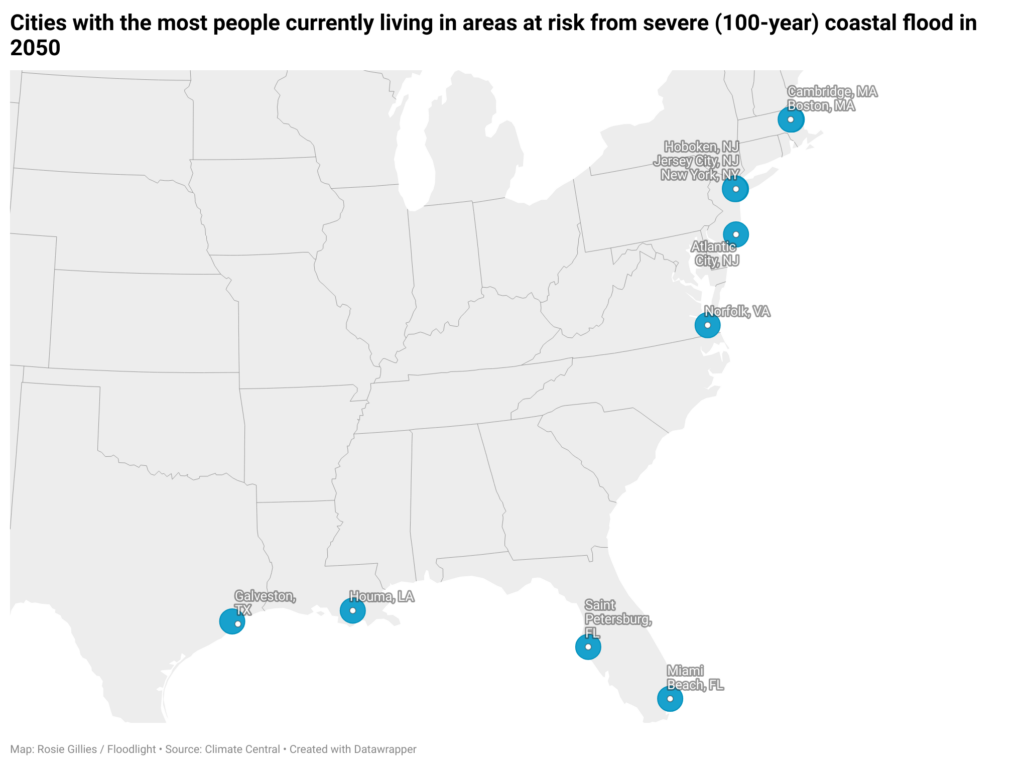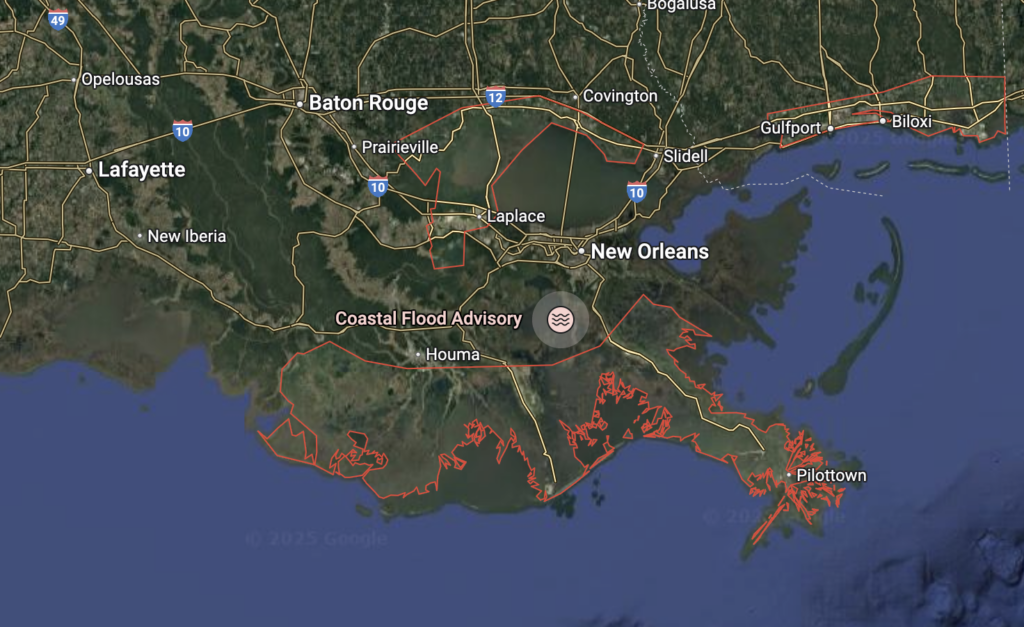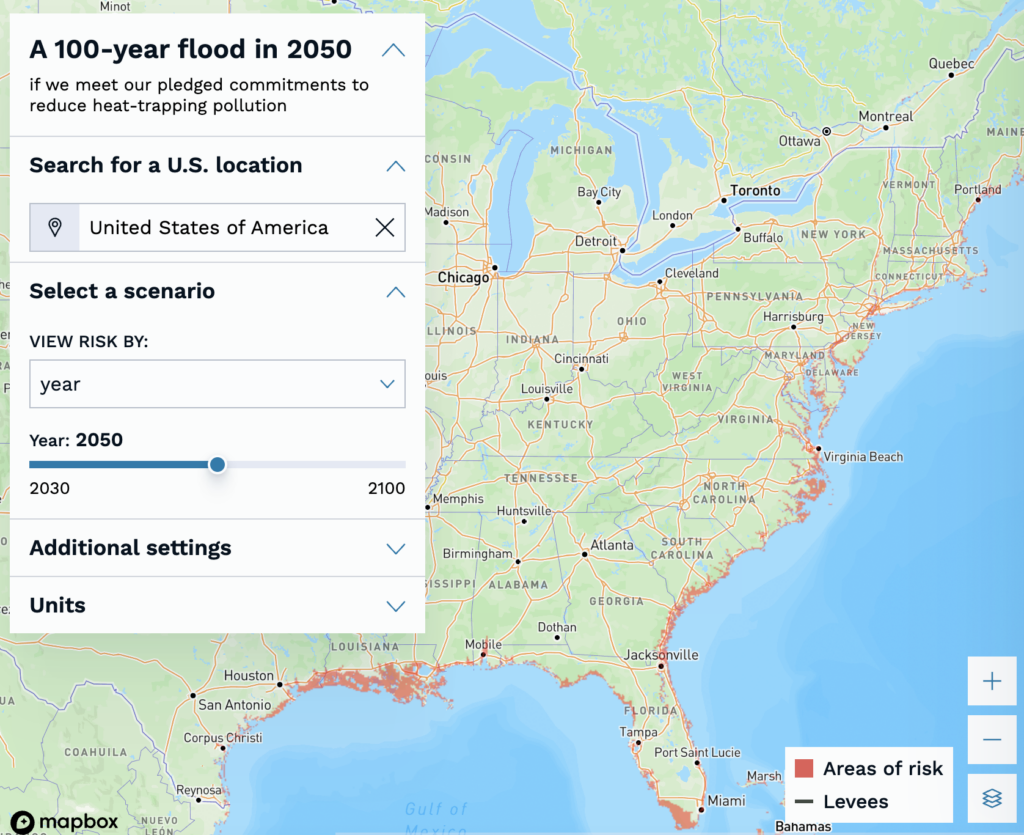This story was originally published by Floodlight.
By Terry L. Jones, Floodlight
Flooding in coastal areas of the United States is projected to occur 10 times more often over the next 25 years, with about 2.5 million people and 1.4 million homes facing severe property damage from sea level rise, according to a new analysis released Wednesday by Climate Central.

And that’s only if countries keep their commitments to reduce greenhouse gas emissions by 2050 as outlined in the Paris Agreement — the international treaty geared toward climate mitigation and greenhouse reduction. President Donald Trump pulled the United States — the No. 2 greenhouse gas emitter after China — from the agreement days after entering office, saying it would strengthen the U.S. economy.
“The current administration is going in kind of the opposite direction of where data says we would need to go if we want to reduce risk,” said Kristina Dahl, vice president of science for Climate Central, a nonprofit group of independent scientists and climate change researchers.
Climate Central has developed a Coastal Risk Finder tool for the public and policy makers to map the flooding risks for their parts of the country. It paints a dire picture for people living along coastal Florida, New York and New Jersey, where it predicts the largest number of people and homes at risk from severe flooding.
The Gulf Coast region will also see higher rates of sea level rise, the analysis found. The area’s low-lying coasts means larger land areas are at risk of flooding, but Louisiana has a less dense population.
Other takeaways from the analysis include:
- One-quarter of the estimated 1.4 million homes in at-risk areas are in Florida.
- About 20% of the people living in areas at risk of coastal flooding are 65 years or older, despite comprising only 16% of total population in those areas.
- New York City has the most people currently living in areas at risk of a severe flood in 2050 — an estimated 271,000 people.
Louisiana’s people, land at risk
Louisiana is ranked fourth in the report’s list of states with the most population at risk from severe coastal flooding in the coming 25 years, but it tops the list when it comes to the amount of land loss from coastal flooding by 2050 — approximately 9,200 square miles.
The state has been well aware of the dangers on its coastline, which has eroded at a rate of about 5,700 acres of wetlands a year between 1974 and 1990.
Since 2007, Louisiana has spent billions on coastal restoration and projects aimed at reducing the risks of land loss and mitigating flooding. The state Coastal Protection and Restoration Authority’s ambitious plan is funded primarily with settlement money from the 2010 Deepwater Horizon oil spill.

But some of those efforts have been stalled by Republican Gov. Jeff Landry, who has voiced opposition to one of the plan’s crucial yet controversial projects — a $3 billion sediment diversion project on the Mississippi River that has split residents, environmentalists and public officials.
“I do believe that if we can advance some of these large scale projects that are in this master plan, it gives us a chance at a sustainable coast and a sustainable future,” said Katie G. Daniel, strategy and campaign manager for the Environmental Defense Fund’s Climate Resilient Coasts and Watersheds program.
More than half of Louisiana voters polled believe coastal land loss will have an effect on them within the next 10 years, according to a 2023 survey published by the Restore the Mississippi River Delta coalition, which the EDF belongs to along with the National Audubon Society, National Wildlife Federation and Pontchartrain Conservancy. The survey found voters “overwhelmingly” favored coastal restoration efforts.
Daniel thinks Louisiana could have a “long-term solution” to the problem with its coastal restoration master plan and natural resources like the Mississippi River, which — through sediment and water diversion projects — could help shore up the state’s coastline and mitigate flood risk.
“We are at a turning point,” she said. “If we can work through the political machinations I just think there’s a lot of opportunity there on the local and the state level.”
Climate efforts lagging
A majority of the cities at the top of Climate Central’s analysis are in the Northeast. Houma in southeast Louisiana is the only one where 100% of its population (33,000 people) are at risk of facing a 100-year-flood by 2050.

Climate Central used population and homes data from the U.S. Census Bureau, coupled with elevation data from the National Oceanic and Atmospheric Administration and U.S. Army Corps of Engineers’ National Levee Database to make calculations based on current global emissions reduction pledges.
Dahl said federal and local governments need to focus on resilience efforts like ensuring there are multiple evacuation routes, upgrading seawalls and facilitating buyouts and relocation programs for those most at risk.
“But then also reducing emissions as quickly and as steeply as we can as a planet is going to be in the long term, one of the biggest things that we can do to keep people safe,” she added.
Former President Joe Biden had pledged to reduce U.S. greenhouse gas emissions by more than 60% from 2005 levels by 2035. The ultimate goal was achieving net-zero emissions by 2050 through a bevy of initiatives focused on climate change and environmental justice in his multi-billion-dollar Inflation Reduction Act (IRA).
But the Trump administration is rolling back much of the IRA spending — along with many federal regulations around greenhouse gas emissions implemented under Biden.
“Countries aren’t on track to meet their current commitments,” Dahl said. “So it could be worse.”
Floodlight is a nonprofit newsroom that investigates the powers stalling climate action. Banner photo: Sunny-day flooding in downtown Miami (B137, CC BY-SA 4.0, via Wikimedia Commons).
Sign up for The Invading Sea newsletter by visiting here. To support The Invading Sea, click here to make a donation. If you are interested in submitting an opinion piece to The Invading Sea, email Editor Nathan Crabbe at ncrabbe@fau.edu.



